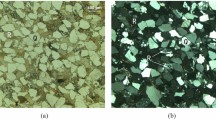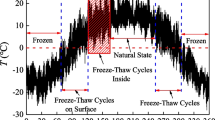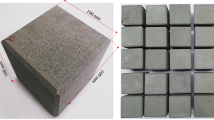Abstract
To deeply understand the rock failure characteristics under actual engineering condition, in which static geo-stress and dynamic disturbance usually act simultaneously, impact tests were conducted on sandstone subjected to axial static pre-stresses varying from 0 to 75 MPa by a modified split Hopkinson pressure bar. The fracturing process of specimens was recorded by a high speed camera. Dynamic parameters of sandstone, such as strain rate, dynamic strength and energy partition were acquired. Fracture mechanisms of pulverized specimens were identified by the method combining the displacement trend line and digital image correlation technique. Moreover, fragments of failed specimens were sieved to obtain the fragment size distribution. Test results revealed that, under the same incident energy, the dynamic compressive strength increases first, then decreases slowly and at last drops rapidly with the increase of pre-stress, and reaches the maximum under 24.4% of uniaxial compressive strength due to the closure of initial defects. Four final patterns were observed, namely intact, axial split, rock burst, and pulverization. The rock burst only occurs when the pre-stress lies in the elastic deformation stage or initial stable crack growth stage and the incident energy is intermediate. For pulverized specimens, the fracture mechanism is transformed into shear/tensile equivalent from tensile-dominated mixed mode as the pre-stress increases. Specimens with 75 MPa pre-stress release strain energy during failure process, contrary to specimens with lower pre-stresses absorbing energy from outside. The crushing degree of pulverized specimens exhibits a positive correlation with the pre-stress as a consequence of higher damage development in rock.






















Similar content being viewed by others
References
Amann F, Button EA, Evans KF et al (2011) Experimental study of the brittle behavior of clay shale in rapid unconfined compression. Rock Mech Rock Eng 44:415–430. https://doi.org/10.1007/s00603-011-0156-3
ASTM:D6913/D6913M-17 (2017) Standard test methods for particle-size distribution (gradation) of soils using sieve analysis. ASTM International, West Conshohocken. https://doi.org/10.1520/D6913_D6913M-17
Basu A, Mishra DA, Roychowdhury K (2013) Rock failure modes under uniaxial compression, Brazilian, and point load tests. Bull Eng Geol Environ 72:457–475. https://doi.org/10.1007/s10064-013-0505-4
Bell FG (1978) The physical and mechanical properties of the fell sandstones, Northumberland, England. Eng Geol 12:1–29. https://doi.org/10.1016/0013-7952(78)90002-9
Bieniawski ZT (1967a) Mechanism of brittle fracture of rock; part I-theory of the fracture process. Int J Rock Mech Min Sci 4:395–404. https://doi.org/10.1016/0148-9062(67)90030-7
Bieniawski ZT (1967b) Mechanism of brittle fracture of rock. Part II-experimental studies. Int J Rock Mech Min Sci 4:407–408. https://doi.org/10.1016/0148-9062(67)90030-7
Bieniawski ZT, Bernede MJ (1979) Suggested methods for determining the uniaxial compressive strength and deformability of rock materials. Part 1. Suggested method for determination of the uniaxial compressive strength of rock materials. Int J Rock Mech Min Sci Geomech Abstr 16:138–140. https://doi.org/10.1016/0148-9062(79)91450-5
Brace WF, Paulding BW, Scholz C (1966) Dilatancy in the fracture of crystalline rocks. J Geophys Res 71:3939–3953. https://doi.org/10.1029/JZ071i016p03939
Bräuner G (2017) Rockbursts in coal mines and their prevention. Routledge, London
Brown ET (1977) Fundamentals of rock mechanics. Tectonophysics. https://doi.org/10.1109/CHICC.2006.4347103
Cadoni E, Labibes K, Albertini C et al (2001) Strain-rate effect on the tensile behaviour of concrete at different relative humidity levels. Mater Struct 34:21–26. https://doi.org/10.1007/BF02482196
Chen R, Li K, Xia K et al (2016) Dynamic fracture properties of rocks subjected to static pre-load using notched semi-circular bend method. Rock Mech Rock Eng 49:3865–3872. https://doi.org/10.1007/s00603-016-0958-4
Dai F, Huang S, Xia K, Tan Z (2010) Some fundamental issues in dynamic compression and tension tests of rocks using split Hopkinson pressure bar. Rock Mech Rock Eng 43:657–666. https://doi.org/10.1007/s00603-010-0091-8
Daphalapurkar NP, Ramesh KT, Graham-Brady L, Molinari JF (2011) Predicting variability in the dynamic failure strength of brittle materials considering pre-existing flaws. J Mech Phys Solids 59:297–319. https://doi.org/10.1016/j.jmps.2010.10.006
Doan ML, D’Hour V (2012) Effect of initial damage on rock pulverization along faults. J Struct Geol 45:113–124. https://doi.org/10.1016/j.jsg.2012.05.006
Doan ML, Gary G (2009) Rock pulverization at high strain rate near the SanAndreas fault. Nat Geosci 2:709–712. https://doi.org/10.1038/ngeo640
Eberhardt E, Stead D, Stimpson B, Read RS (1998) Identifying crack initiation and propagation thresholds in brittle rock. Can Geotech J 35:222–233. https://doi.org/10.1139/t97-091
Eberhardt E, Stead D, Stimpson B (1999) Quantifying progressive pre-peak brittle fracture damage in rock during uniaxial compression. Int J Rock Mech Min Sci 36:361–380. https://doi.org/10.1016/S0148-9062(99)00019-4
Ergin H, Acaroglu O (2007) The effect of machine design parameters on the stability of a roadheader. Tunn Undergr Sp Technol 22:80–89. https://doi.org/10.1016/j.tust.2006.04.003
Feng P, Dai F, Liu Y et al (2018) Coupled effects of static–dynamic strain rates on the mechanical and fracturing behaviors of rock-like specimens containing two unparallel fissures. Can Geotech J 55:640–652. https://doi.org/10.1139/cgj-2017-0286
Gao G, Huang S, Xia K, Li Z (2015) Application of digital image correlation (DIC) in dynamic notched semi-circular bend (NSCB) Tests. Exp Mech 55:95–104. https://doi.org/10.1007/s11340-014-9863-5
Gong F, Li X, Liu X, Zhao J (2010) Experimental study of dynamic characteristics of sandstone under one-dimensional coupled static and dynamic loads. Chin J Rock Mech Eng 29:2076–2085. https://doi.org/10.13722/j.cnki.jrme.2014.10.013
Gong QM, Yin LJ, Wu SY et al (2012) Rock burst and slabbing failure and its influence on TBM excavation at headrace tunnels in Jinping II hydropower station. Eng Geol 124:98–108. https://doi.org/10.1016/j.enggeo.2011.10.007
Gray III GT (2000) Classic split-Hopkinson pressure bar testing. ASM handbook 8:462–476
Hamiel Y, Lyakhovsky V, Agnon A (2004) Coupled evolution of damage and porosity in poroelastic media: theory and applications to deformation of porous rocks. Geophys J Int 156:701–713. https://doi.org/10.1111/j.1365-246X.2004.02172.x
He M, Xia H, Jia X et al (2012) Studies on classification, criteria and control of rockbursts. J Rock Mech Geotech Eng 4:97–114. https://doi.org/10.3724/SP.J.1235.2012.00097
He MC, Zhao F, Cai M, Du S (2015) A novel experimental technique to simulate pillar burst in laboratory. Rock Mech Rock Eng 48:1833–1848. https://doi.org/10.1007/s00603-014-0687-5
Hong L, Zhou ZL, Yin TB et al (2009) Energy consumption in rock fragmentation at intermediate strain rate. J Cent South Univ 16:0677–0682. https://doi.org/10.1007/s11771-009-0112-5
Huang RQ, Wang XN (1999) Analysis of dynamic disturbance on rock burst. Bull Eng Geol Environ 57:281–284. https://doi.org/10.1007/s100640050046
Jain M, Hefny AM, Chen SG et al (2002) Rock dynamics research related to cavern development for Ammunition storage. Tunn Undergr Sp Technol 14:513–526. https://doi.org/10.1016/s0886-7798(00)00013-4
Jalali SME, Zare Naghadehi M (2013) Development of a new laboratory apparatus for the examination of the rotary-percussive penetration in tunnel boring machines. Tunn Undergr Sp Technol 33:88–97. https://doi.org/10.1016/j.tust.2012.10.002
Jiang Q, Su GS, Feng XT et al (2015) Observation of rock fragment ejection in post-failure response. Int J Rock Mech Min Sci 74:30–37. https://doi.org/10.1016/j.ijrmms.2014.11.007
Kang H, Cho JW, Park JY et al (2016) A new linear cutting machine for assessing the rock-cutting performance of a pick cutter. Int J Rock Mech Min Sci 88:129–136. https://doi.org/10.1016/j.ijrmms.2016.07.021
Lajtai EZ, Lajtai VN (1974) The evolution of brittle fracture in rocks. J Geol Soc London 130:1–16. https://doi.org/10.1144/gsjgs.130.1.0001
Lee CF, Sijing W, Zhifu Y (1996) Geotechnical aspects of rock tunnelling in China. Tunn Undergr Sp Technol 11:445–454. https://doi.org/10.1016/S0886-7798(96)89242-X
Li X (2014) Rock dynamics: fundamentals and applications. Science Press, Beijing
Li HB, Zhao J, Li TJ (2000) Micromechanical modelling of the mechanical properties of a granite under dynamic uniaxial compressive loads. Int J Rock Mech Min Sci 37:923–935. https://doi.org/10.1016/S1365-1609(00)00025-3
Li XB, Summers DA, Rupert G, Santi P (2001) Experimental investigation on the breakage of hard rock by the PDC cutters with combined action modes. Tunn Undergr Sp Technol 16:107–114. https://doi.org/10.1016/S0886-7798(01)00036-0
Li XB, Lok TS, Zhao J (2005) Dynamic characteristics of granite subjected to intermediate loading rate. Rock Mech Rock Eng 38:21–39. https://doi.org/10.1007/s00603-004-0030-7
Li X, Zhou Z, Lok TS et al (2008) Innovative testing technique of rock subjected to coupled static and dynamic loads. Int J Rock Mech Min Sci 45:739–748. https://doi.org/10.1016/j.ijrmms.2007.08.013
Li X, Gong F, Zhao J et al (2010) Test study of impact failure of rock subjected to one-dimensional coupled static and dynamic loads. Yanshilixue Yu Gongcheng Xuebao/Chin J Rock Mech Eng 29:251–260
Li T, Ma C, Zhu M et al (2017a) Geomechanical types and mechanical analyses of rockbursts. Eng Geol 222:72–83. https://doi.org/10.1016/j.enggeo.2017.03.011
Li X, Gong F, Tao M et al (2017b) Failure mechanism and coupled static–dynamic loading theory in deep hard rock mining: a review. J Rock Mech Geotech Eng 9:767–782. https://doi.org/10.1016/j.jrmge.2017.04.004
Li D, Han Z, Sun X et al (2018a) Dynamic mechanical properties and fracturing behavior of marble specimens containing single and double flaws in SHPB tests. Rock Mech Rock Eng. https://doi.org/10.1007/s00603-018-1652-5
Li X, Wang S, Wang S (2018b) Experimental investigation of the influence of confining stress on hard rock fragmentation using a conical pick. Rock Mech Rock Eng 51:255–277. https://doi.org/10.1007/s00603-017-1309-9
Li D, Xiao P, Han Z, Zhu Q (2018c) Mechanical and failure properties of rocks with a cavity under coupled static and dynamic loads. Eng Fract Mech. https://doi.org/10.1016/j.engfracmech.2018.10.021
Liang CY, Zhang QB, Li X, Xin P (2016) The effect of specimen shape and strain rate on uniaxial compressive behavior of rock material. Bull Eng Geol Environ 75:1669–1681. https://doi.org/10.1007/s10064-015-0811-0
Ma S, Chen W, Zhao W (2019) Effects of axial static stress and confining pressure on the dynamic compressive behaviours of granite. Eur J Environ Civ Eng. https://doi.org/10.1080/19648189.2018.1547665
Ning J, Fang M, Ren H (2010) An interacting micro-cracks damage constitutive model for alumina ceramics under uniaxial compression. Int J Nonlinear Sci Numer Simul 11(Suppl):183–188. https://doi.org/10.1515/ijnsns.2010.11.s1.183
Ohnaka M, Mogi K (1982) Frequency characteristics of acoustic emission in rocks under uniaxial compression and its relation to the fracturing process to failure. J Geophys Res 87:3873–3884. https://doi.org/10.1029/JB087iB05p03873
Ortlepp WD (2001) The behaviour of tunnels at great depth under large static and dynamic pressures. Tunn Undergr Sp Technol 16:41–48. https://doi.org/10.1016/S0886-7798(01)00029-3
Paliwal B, Ramesh KT (2008) An interacting micro-crack damage model for failure of brittle materials under compression. J Mech Phys Solids 56:896–923. https://doi.org/10.1016/j.jmps.2007.06.012
Paterson M, Wong T (2005) Experimental rock deformation-the brittle field. Springer, Berlin
Ravi-Chandar K, Knauss WG (1984) An experimental investigation into dynamic fracture: III. On steady-state crack propagation and crack branching. Int J Fract 26:141–154. https://doi.org/10.1007/BF01157550
Shi D, Chen X (2018) Flexural tensile fracture behavior of pervious concrete under static preloading. J Mater Civ Eng 30:06018015. https://doi.org/10.1061/(ASCE)MT.1943-5533.0002477
Song B, Chen W (2006) Energy for specimen deformation in a split Hopkinson pressure bar experiment. Exp Mech 46:407–410. https://doi.org/10.1007/s11340-006-6420-x
Sutton MA, Orteu JJ, Schreier HW (2009) Image correlation for shape, motion and deformation measurements-basic concepts, theory and applications. Springer Science Business Media, New York. https://doi.org/10.1007/978-0-387-78747-3
Tao M, Ma A, Cao W et al (2017) Dynamic response of pre-stressed rock with a circular cavity subject to transient loading. Int J Rock Mech Min Sci 99:1–8. https://doi.org/10.1016/j.ijrmms.2017.09.003
Tuncay E, Hasancebi N (2009) The effect of length to diameter ratio of test specimens on the uniaxial compressive strength of rock. Bull Eng Geol Environ 68:491–497. https://doi.org/10.1007/s10064-009-0227-9
Wang S, Li X, Yao J et al (2019) Experimental investigation of rock breakage by a conical pick and its application to non-explosive mechanized mining in deep hard rock. Int J Rock Mech Min Sci 122:104063. https://doi.org/10.1016/j.ijrmms.2019.104063
Wasantha PLP, Ranjith PG (2014) Water-weakening behavior of Hawkesbury sandstone in brittle regime. Eng Geol 178:91–101. https://doi.org/10.1016/j.enggeo.2014.05.015
Wasantha PLP, Ranjith PG, Permata G, Bing D (2018) Damage evolution and deformation behaviour of dry and saturated sandstones: insights gleaned from optical measurements. Meas J Int Meas Confed 130:8–17. https://doi.org/10.1016/j.measurement.2018.07.075
Weng L, Li X, Taheri A et al (2018a) Fracture evolution around a cavity in brittle rock under uniaxial compression and coupled static–dynamic loads. Rock Mech Rock Eng 51:531–545. https://doi.org/10.1007/s00603-017-1343-7
Weng L, Wu Z, Li X (2018b) Mesodamage Characteristics of Rock with a Pre-cut Opening Under Combined static–Dynamic Loads: a Nuclear Magnetic Resonance (NMR) Investigation. Rock Mech Rock Eng 51:2339–2354. https://doi.org/10.1007/s00603-018-1483-4
Wong LNY, Li Z, Kang HM, Teh CI (2017) Dynamic loading of Carrara marble in a heated state. Rock Mech Rock Eng 50:1487–1505. https://doi.org/10.1007/s00603-017-1170-x
Wu B, Chen R, Xia K (2015) Dynamic tensile failure of rocks under static pre-tension. Int J Rock Mech Min Sci 80:12–18. https://doi.org/10.1016/j.ijrmms.2015.09.003
Wu B, Yao W, Xia K (2016) An experimental study of dynamic tensile failure of rocks subjected to hydrostatic confinement. Rock Mech Rock Eng 49:3855–3864. https://doi.org/10.1007/s00603-016-0946-8
Xia K, Huang S, Dai F (2013) Evaluation of the frictional effect in dynamic notched semi-circular bend tests. Int J Rock Mech Min Sci 62:148–151. https://doi.org/10.1016/j.ijrmms.2013.06.001
Xia K, Xu Y, Yao W, Gao G (2017) Experimental study of dynamic fracture behavior of brittle rockplate under static pre-loading. Chin J Rock Mech Eng 36:1122–1132. https://doi.org/10.13722/j.cnki.jrme.2016.1278
Xu Y, Dai F, Xu NW, Zhao T (2016) Numerical investigation of dynamic rock fracture toughness determination using a semi-circular bend specimen in split Hopkinson pressure bar testing. Rock Mech Rock Eng 49:731–745. https://doi.org/10.1007/s00603-015-0787-x
Xue L, Qin S, Sun Q et al (2014) A study on crack damage stress thresholds of different rock types based on uniaxial compression tests. Rock Mech Rock Eng 47:1183–1195. https://doi.org/10.1007/s00603-013-0479-3
Yao W, Xia K, Jha AK (2018) Experimental study of dynamic bending failure of Laurentian granite: loading rate and pre-load effects. Can Geotech J 56:228–235. https://doi.org/10.1139/cgj-2017-0707
Yin ZQ, Li XB, Jin JF et al (2012) Failure characteristics of high stress rock induced by impact disturbance under confining pressure unloading. Trans Nonferrous Met Soc China 22:175–184. https://doi.org/10.1016/s1003-6326(11)61158-8(English Ed)
Yin ZQ, Ma HF, Hu ZX, Zou Y (2014) Effect of static–dynamic coupling loading on fracture toughness and failure characteristics in marble. J Eng Sci Technol Rev 7:169–174. https://doi.org/10.25103/jestr.072.25
Yin T, Bai L, Li X et al (2018) Effect of thermal treatment on the mode I fracture toughness of granite under dynamic and static coupling load. Eng Fract Mech 199:143–158. https://doi.org/10.1016/j.engfracmech.2018.05.035
Zhang ZX (2016) Rock fracture and blasting: theory and applications. Butterworth-Heinemann
Zhang XP, Wong LNY (2014) Displacement field analysis for cracking processes in bonded-particle model. Bull Eng Geol Environ 73:13–21. https://doi.org/10.1007/s10064-013-0496-1
Zhang QB, Zhao J (2013) Determination of mechanical properties and full-field strain measurements of rock material under dynamic loads. Int J Rock Mech Min Sci 60:423–439. https://doi.org/10.1016/j.ijrmms.2013.01.005
Zhang QB, Zhao J (2014) A review of dynamic experimental techniques and mechanical behaviour of rock materials. Rock Mech Rock Eng 47:1411–1478. https://doi.org/10.1007/s00603-013-0463-y
Zhang Z, Kou S, Jiang L, Lindqvist P (2000) Effects of loading rate on rock fracture: fracture characteristics and energy partitioning. Int J Rock Mech Min Sci 37:745–762. https://doi.org/10.1016/S1365-1609(00)00008-3
Zhou Z, Li X, Ye Z, Liu K (2010) Obtaining constitutive relationship for rate-dependent rock in SHPB tests. Rock Mech Rock Eng 43:697–706. https://doi.org/10.1007/s00603-010-0096-3
Zhou Z, Li X, Liu A, Zou Y (2011) Stress uniformity of split Hopkinson pressure bar under half-sine wave loads. Int J Rock Mech Min Sci 48:697–701. https://doi.org/10.1016/j.ijrmms.2010.09.006
Zhou YX, Xia K, Li XB et al (2012) Suggested methods for determining the dynamic strength parameters and mode-I fracture toughness of rock materials. Int J Rock Mech Min Sci 49:105–112. https://doi.org/10.1016/j.ijrmms.2011.10.004
Zhou Z, Li X, Zou Y et al (2014) Dynamic Brazilian tests of granite under coupled static and dynamic loads. Rock Mech Rock Eng 47:495–505. https://doi.org/10.1007/s00603-013-0441-4
Zhou Z, Cai X, Cao W et al (2016) Influence of water content on mechanical properties of rock in both saturation and drying processes. Rock Mech Rock Eng 49:3009–3025. https://doi.org/10.1007/s00603-016-0987-z
Zhou Z, Tan L, Cao W et al (2017) Fracture evolution and failure behaviour of marble specimens containing rectangular cavities under uniaxial loading. Eng Fract Mech 184:183–201. https://doi.org/10.1016/j.engfracmech.2017.08.029
Zhou Z, Cai X, Ma D et al (2018a) Dynamic tensile properties of sandstone subjected to wetting and drying cycles. Constr Build Mater 182:215–232. https://doi.org/10.1016/j.conbuildmat.2018.06.056
Zhou Z, Cai X, Ma D et al (2018b) Effects of water content on fracture and mechanical behavior of sandstone with a low clay mineral content. Eng Fract Mech 193:47–65. https://doi.org/10.1016/j.engfracmech.2018.02.028
Zhou Z, Cai X, Ma D et al (2019) Water saturation effects on dynamic fracture behavior of sandstone. Int J Rock Mech Min Sci 114:46–61. https://doi.org/10.1016/j.ijrmms.2018.12.014
Zhu W, Li S, Li S, Niu L (2018) Influence of dynamic disturbance on the creep of sandstone: an experimental study. Rock Mech Rock Eng. https://doi.org/10.1007/s00603-018-1642-7
Zhu Q, Li D, Han Z et al (2019) Mechanical properties and fracture evolution of sandstone specimens containing different inclusions under uniaxial compression. Int J Rock Mech Min Sci 115:33–47. https://doi.org/10.1016/j.ijrmms.2019.01.010
Acknowledgements
The work is supported by financial grants from the National Basic Research Program of China (2015CB060200), the National Natural Science Foundation of China (41772313), the Natural Science Foundation of Hunan (2015JJ4067) and the Graduated Students’ Research and Innovation Fund Project of Central South University (2018zzts210). The authors are very grateful to the financial contribution and convey their appreciation for supporting this basic research. The authors also wish to thank Mr. Haizhi Zang and Mr. Fu liu from Central South University for their help in experiments, and to Dr. Lu Chen from the Changsha University of Science and Technology for his fruitful discussion on the DIC analysis.
Author information
Authors and Affiliations
Corresponding author
Ethics declarations
Conflict of interest
The authors declare that they have no conflict of interest.
Additional information
Publisher's Note
Springer Nature remains neutral with regard to jurisdictional claims in published maps and institutional affiliations.
Rights and permissions
About this article
Cite this article
Zhou, Z., Cai, X., Li, X. et al. Dynamic Response and Energy Evolution of Sandstone Under Coupled Static–Dynamic Compression: Insights from Experimental Study into Deep Rock Engineering Applications. Rock Mech Rock Eng 53, 1305–1331 (2020). https://doi.org/10.1007/s00603-019-01980-9
Received:
Accepted:
Published:
Issue Date:
DOI: https://doi.org/10.1007/s00603-019-01980-9




